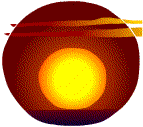The Green Flash - a Personal Perspective
Created | Updated Aug 22, 2017

Jules Verne knew about the green flash in 1882 and made it the theme of his book Le Rayon-Vert. The green ray was explained to scientists at least two decades before that. It was revealed to this researcher recently after someone mentioned he had seen a 'green flash'.
I determined to check out this observation, so very early one morning the cause of investigative journalism took a giant step forward in New Zealand. It was to be a bright new-summer's day, although that was not apparent at the time. A milk truck 'tink' led somewhere and hedgehogs snuffled in the dark. As the night dissolved I climbed the path running along the cliff-top, smelling the jasmine in the still air and hoping not to run into one of the lonely souls who use this place to hike off the planet. The sea shushed on rocks too far below to see without going to the edge and feeling every sinew and intestine cringing, go back! And just as the sun lifted over the horizon, green light erupted momentarily from its rim. The green flash! Expecting the phenomenon made it the more unexpected. It was moving for no reason other than being something rare and beautiful, as emotional as the flukes of a whale sounding off the Kaikoura coast.
So What is It?
You can also see the green flash as the sun sets. The flash is an elusive beast, so seldom seen that it has excited curiosity and mysticism since the great 19th Century physicist James Joule published a short account of it in the Proceedings of the Manchester Literary and Philosophical Society in 1869. Explanations of the flash move through several thickets of obscurity, but Alan Gilmore, an astronomer at the Mt John Observatory in the clear alpine skies near Lake Tekapo, NZ, provides one of the more comprehensible, not to mention concise, explanations. If you look at a bright star low in the sky through a telescope, he says, instead of a pinpoint of light it appears as a spectrum, a band of colour ranging from blue through green, yellow and red. Similarly, a rising or setting sun becomes a whole series of overlapping discs running through the colours of the spectrum.
The red sun disappears first. Its light is refracted or bent least. The yellows and oranges are absorbed by ozone and vanish, too. The blues/indigos/violets should be last, but they get scattered by the atmosphere (one of the reasons why the sky is blue) otherwise we would see a blue flash. So the last piece of colour from the sun that the watcher sees is the surviving emerald green: the green flash. When the sun rises the colours work in reverse, so the first bit you see is the green.
There are plenty of limiting factors to stop you seeing the flash, however.
It must be a clear morning, or evening. Clouds, smoke or haze stop the show in its tracks. It happens more clearly when the set, or rise, is truly at the horizon, so over the ocean in a cloudless sky is your best chance of catching it. Standing on tall buildings, or mountains, or riding in balloons or aeroplanes is recommended. Binoculars are good as long as most of the sun is below the horizon so it doesn't damage eyes.
Anyway, you have to be sharp. The green flash lasts only a fraction of a second (one-fortieth, according to one measurement), although Gilmore cites a Dutch astronomer watching the sunset. In the higher latitudes of the Netherlands the sun sets more obliquely; the astronomer found he could make the flash last several seconds by running backwards up a dyke.
In his book Jules Verne cites an old Scottish legend. Someone who has seen the green flash is incapable of being deceived, and is 'enabled to see closely into his own heart and to read the thoughts of others'.
The jury is still out on that one, but it's a good thought.

